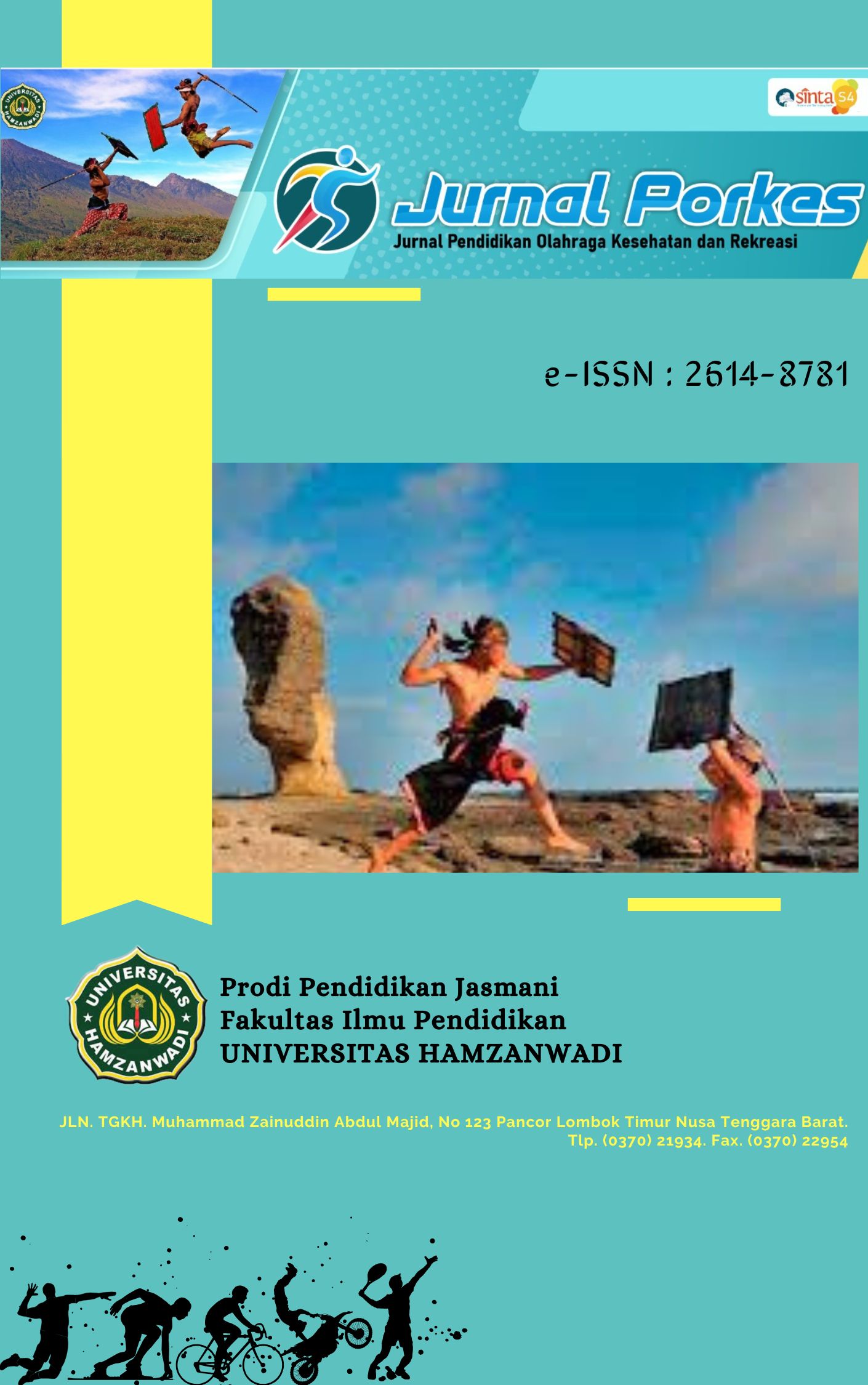Enhancing Long Jump Abilities through Engklek and Jump Rope: A Study on Traditional Games in Physical Education
DOI:
https://doi.org/10.29408/porkes.v8i2.29524Keywords:
Traditional games; motor skills; long jump; physical education.Abstract
The development of motor skills during childhood is critical for overall physical fitness and athletic performance. Traditional games, which are often culturally significant, play a vital role in enhancing these skills. This study aims to assess the impact of traditional games (e.g., Engklek and Lompat Tali) on the long jump performance of students at Elementary School 5 Kikim Timur. A comparative design was employed with a sample of 24 male students from Elementary School 5 Kikim Timur. The participants were randomly divided into two groups: Engklek and Lompat Tali, with 12 students in each group. Motor skills were assessed through standardized tests focusing on agility, coordination, explosive power, and speed. Long jump performance was evaluated based on four components: take-off, push, flight, and landing. Data analysis involved homogeneity and normality tests using SPSS version 23, followed by a one-way ANOVA test with a significance threshold of p < 0.05. Significant differences were found in long jump performance between the two groups. The incorporation of traditional games contributes to improved motor skills, enabling students to enhance their long-jump abilities effectively. Integrating traditional games into physical education programs offers a culturally relevant and engaging approach to improving motor skills and athletic performance. This study highlights the need for further research to explore the long-term benefits and potential applications of traditional games in various sports disciplines.
References
Abdel-Maksoud, G., Abdel-Hamied, M., & El-Shemy, H. A. (2021). Analytical Techniques Used for Condition Assessment of a Late Period Mummy. Journal of Cultural Heritage, 48, 83–92. https://doi.org/10.1016/j.culher.2021.01.001
Adolph, K. E., & Hoch, J. E. (2020). The Importance of Motor Skills for Development. In Nestlé Nutrition Institute Workshop Series. 95(1). 136–144). S. Karger AG. https://doi.org/10.1159/000511511
Arianda, E., Rustiadi, T., & Kusuma, D. W. Y. (2021). The Effect of Plyometric and Resistance Training on Increasing the Speed and Explosive Power of the Leg Muscles. Journal of Physical Education and Sports. 10(2). 200-210. https://journal.unnes.ac.id/sju/jpes/article/view/48415
Ashar A., Mania S., Ibrahim M. M., Syamsudduha St., Sadaruddin S., & Dewi A. C. (2024). The Impact of Traditional Games on Social-Emotional Development: A Comprehensive Review of Existing Research. Journal of Learning and Development Studies, 4(2), 39–51. https://doi.org/10.32996/jlds.2024.4.2.5
Anggoro, B., Masrun, M. (2023) Effects of Plyometric Exercise and Motivation on the Explosive Power of Volleyball Players' Limb Muscles. Jorpres (Jurnal Olahraga Prestasi). 19(2). 86-96. https://journal.uny.ac.id/index.php/jorpres/article/view/64374
Bremer, E., & Cairney, J. (2016). Fundamental Movement Skills and Health-Related Outcomes: A Narrative Review of Longitudinal and Intervention Studies Targeting Typically Developing Children. American Journal of Lifestyle Medicine, 12(2), 148–159. https://doi.org/10.1177/1559827616640196
Burhaein, E., Tarigan, B., & Phytanza, D. T. P. (2020). The Experiences and Understandings of the K-13 Curriculum Implementation of Indonesian Teachers of Adapted Physical Education (APE). International Sports Studies, 42(3), 29–42. https://doi.org/10.30819/iss.42-e.04
Creswell, J. W. (2014). Research Design: Qualitative, Quantitative, and Mixed Methods Approaches. SAGE.
Creswell, J. W., & Creswell, J. D. (2018). Research Design: Qualitative, Quantitative, and Mixed Methods Approaches. SAGE Publications.
Dapp, L. C., Gashaj, V., & Roebers, C. M. (2021). Physical Activity and Motor Skills in Children: A Differentiated Approach. Psychology of Sport and Exercise, 54, 101916. https://doi.org/10.1016/j.psychsport.2021.101916
Fiorilli, G., Mitrotasios, M., Iuliano, E., Pistone, E. M., Aquino, G., Calcagno, G., & Di Cagno, A. (2017). Agility and Change of Direction in Soccer: Differences According to the Player Ages. The Journal of Sports Medicine and Physical Fitness, 57(12). 1597-604 https://doi.org/10.23736/S0022-4707.16.06562-2
Gescheit, D. T., Cormack, S. J., Reid, M., & Duffield, R. (2015). Consecutive Days of Prolonged Tennis Match Play: Performance, Physical, and Perceptual Responses in Trained Players. International Journal of Sports Physiology. 10(7). 913 – 920. https://opus.lib.uts.edu.au/handle/10453/118907
Harvey, S. P., Lambourne, K., Greene, J. L., Gibson, C. A., Lee, J., & Donnelly, J. E. (2018). The Effects of Physical Activity on Learning Behaviors in Elementary School Children: A Randomized Controlled Trial. Contemporary School Psychology, 22(3), 303–312. https://doi.org/10.1007/s40688-017-0143-0
Huang, H., Huang, W.-Y., & Wu, C.-E. (2023). The Effect of Plyometric Training on the Speed, Agility, and Explosive Strength Performance in Elite Athletes. Applied Sciences, 13(6), 3605. https://doi.org/10.3390/app13063605
Hussain, B., & Cheong, J. P. G. (2022). Improving Gross Motor Skills of Children Through Traditional Games Skills Practiced Along the Contextual Interference Continuum. Frontiers in Psychology, 13, 986403. https://doi.org/10.3389/fpsyg.2022.986403
Iorga, A., Jianu, A., Gheorghiu, M., Crețu, B. D., & Eremia, I.-A. (2023). Motor Coordination and Its Importance in Practicing Performance Movement. Journal Sustainability. 15(7), 5812. https://doi.org/10.3390/su15075812
Ismoyo, I., Nasrulloh, A., Hermawan, A, H., & Ihsan, F. (2024). Beneficios Para la Salud de los Juegos Tradicionales: Una Revisión Sistemática (Health benefits of traditional games-asystematic review). Journal Retos, 59, 843–856. https://doi.org/10.47197/retos.v59.107467
Kastrena, E., Suherman, A., Ma’mun, A., & Nugraha, E. (2019). Correlation Between Motor Ability and Long Jump Skills of Students. Proceedings of the 3rd International Conference on Sport Science, Health, and Physical Education (ICSSHPE 2018). Proceedings of the 3rd International Conference on Sport Science, Health, and Physical Education (ICSSHPE 2018), Bandung, Indonesia. https://doi.org/10.2991/icsshpe-18.2019.28
Kryeziu, A. R., Iseni, A., Teodor, D. F., Croitoru, H., & Badau, D. (2023). Effect of 12 Weeks of the Plyometric Training Program Model on Speed and Explosive Strength Abilities in Adolescents. Journal Applied Sciences, 13(5), 2776. https://doi.org/10.3390/app13052776
Mahardika, E. K. (2014). Peningkatan Perilaku Sosial Anak Melalui Permainan Tardisional Jawa. Jurnal Pendidikan Usia Dini. 8(2). 1-13. https://journal.unj.ac.id/unj/index.php/jpud/article/view/3588
Makaruk, H., Starzak, M., Suchecki, B., Czaplicki, M., & Stojiljković, N. (2020). The Effects of Assisted and Resisted Plyometric Training Programs on Vertical Jump Performance in Adults: A Systematic Review and Meta-Analysis. Journal of Sports Science & Medicine, 19(2), 347–357. https://pubmed.ncbi.nlm.nih.gov/32390728/
Naidu, B. G. (2016). Impact of Speed Training Combined With Plyometric Training and Intensive Interval Training on Speed Endurance. IOSR Journal of Sports and Physical Education (IOSR-JSPE), 3(6). https://www.iosrjournals.org/
Nurfitriyana, D. (2022). Seru Tren Olahraga Lompat Tali alias Jumping Rope, Apa Saja Manfaat dan Bagaimana Triknya? Good Doctor. https://www.gooddoctor.co.id/hidup-sehat/olahraga/seru-tren-olahraga-lompat-tali-alias-jumping-rope-apa-saja-triknya/
Pramanick, S., Chowdhuri, P., & Rahaman, A. (2022). A Study of Specific Coordinative Abilities between Athletes and Non-Athletes. IOSR Journal of Sports and Physical Education (IOSR-JSPE), 9(1). 4246. https://doi.org/10.9790/6737-09014246
Ramirez-Campillo, R., Andrade, D. C., Nikolaidis, P. T., Moran, J., Clemente, F. M., Chaabene, H., & Comfort, P. (2020). Effects of Plyometric Jump Training on Vertical Jump Height of Volleyball Players: A Systematic Review with Meta-Analysis of Randomized-Controlled Trial. Journal of Sports Science & Medicine, 19(3), 489–499. https://pubmed.ncbi.nlm.nih.gov/32874101/
Rhodes, R. E., Guerrero, M. D., Vanderloo, L. M., Barbeau, K., Birken, C. S., Chaput, J.-P., Faulkner, G., Janssen, I., Madigan, S., Mâsse, L. C., McHugh, T.-L., Perdew, M., Stone, K., Shelley, J., Spinks, N., Tamminen, K. A., Tomasone, J. R., Ward, H., Welsh, F., & Tremblay, M. S. (2020). Development of a Consensus Statement on the Role of the Family in the Physical Activity, Sedentary, and Sleep Behaviours of Children and Youth. International Journal of Behavioral Nutrition and Physical Activity, 17(1), 74-86. https://doi.org/10.1186/s12966-020-00973-0
Rizki, I. A., Suprapto, N., & Admoko, S. (2022). Exploration of Physics Concepts With Traditional Engklek (Hopscotch) Game: Is it Potential in Physics Ethno-STEM Learning? Jurnal Ilmiah Pendidikan Fisika Al-Biruni, 11(1), 19–33. https://doi.org/10.24042/jipfalbiruni.v11i1.10900
Shimray, S. A. (2024). Exploring the Cultural Significance of Traditional Games and Sports Among the Tangkhul Nagas: A Sociocultural Analysis. International Journal For Multidisciplinary Research, 6(4), 25282. https://doi.org/10.36948/ijfmr.2024.v06i04.25282
Woodard, K. F., & Chen, Y. (2024). Effects of Jump Rope Lessons on Physical Skills, Inhibitory Control, and Perceived Enjoyment of Elementary Students. Journal of Teaching in Physical Education. 44(2). 296–305. https://doi.org/10.1123/jtpe.2023-0388
Zubaida, I., Hufad, A., Hendrayana, A., & Leksono, S. M. (2021). The Effect of Traditional Games Bebentengan on Aerobic Capacity and Agility. Juara; Jurnal Olahraga, 6(2), 344–349. https://doi.org/10.33222/juara.v6i2.1359
Downloads
Published
How to Cite
Issue
Section
License
Copyright (c) 2025 Putri Cicilia Kristina, Rizal Fahlifi, Endie Riyoko, Sugarwanto, Siti Ayu Risma Putri

This work is licensed under a Creative Commons Attribution-ShareAlike 4.0 International License.
![]()
Jurnal Porkes is licensed under a Creative Commons Attribution-Share Alike 4.0 International License







